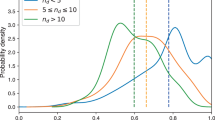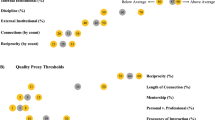Abstract
Funding agencies and researchers are placing increasing emphasis on interdisciplinary research (IDR) to promote innovation and to address complex real-world problems. Understanding characteristics of IDR early (as soon as projects get funded), can formatively shape a research community at portfolio, project, and individual investigator levels. This involves surfacing the interacting components and the context that manifest IDR. We present a network-based methodology to model and analyze IDR, and apply it to a three-year portfolio of awards in the Research on Emerging Technologies for Teaching and Learning program. Our IDR analysis features two network-based metrics (1) diversity of expertise and (2) intensity of inter-expertise collaboration. It reveals the organization of the 116 expertise areas that form the “building blocks” for IDR in this community, while also highlighting potential for knowledge integration, specifically within “hotspot” topics. It also reveals gaps in IDR potential. Applying our network-based methodology for understanding IDR could enable other research domains and communities to conduct early and rapid analyses of the emerging IDR profile in their network, and could inform formative efforts to strengthen IDR.
Access this chapter
Tax calculation will be finalised at checkout
Purchases are for personal use only
Similar content being viewed by others
References
Allenby, B.R., Sarewitz, D.: The techno-human condition. MIT Press (2011)
Borgatti, S.P., Everett, M.G., Johnson, J.C.: Analyzing social networks. Sage (2018)
Börner, K., et al.: Mapping the co-evolution of artificial intelligence, robotics, and the internet of things over 20 years (1998–2017). PLoS ONE 15(12 December), 1–21 (2020). https://doi.org/10.1371/journal.pone.0242984
Borrego, M., Newswander, L.K.: Definitions of interdisciplinary research: Toward graduate-level interdisciplinary learning outcomes. Rev. High. Educ. 34(1), 61–84 (2010)
Calero Valdez, A., et al.: Using mixed node publication network graphs for analyzing success in interdisciplinary teams. In: Huang, R., Ghorbani, A.A., Pasi, G., Yamaguchi, T., Yen, N.Y., Jin, B. (eds.) AMT 2012. LNCS, vol. 7669, pp. 606–617. Springer, Heidelberg (2012). https://doi.org/10.1007/978-3-642-35236-2_61
Cunningham, E., Greene, D.: The Structure of Interdisciplinary Science: Uncovering and Explaining Roles in Citation Graphs. Studies in Computational Intelligence 1077 SCI, 364–376 (2023). https://doi.org/10.1007/978-3-031-21127-0_30
Dossou Kpanou, B., Kelsey, K., Bower, K.: An evaluation of social networks within federally funded research projects. Adv. Agric. Dev. 1(3), 42–54 (2020). https://doi.org/10.37433/aad.v1i3.65
Dörpinghaus, J., Klante, S., Christian, M., Meigen, C., Düing, C.: From social networks to knowledge graphs: a plea for interdisciplinary approaches. Soc. Sci. Humanities Open 6(1), 100,337 (2022). https://doi.org/10.1016/j.ssaho.2022.100337. https://www.sciencedirect.com/science/article/pii/S2590291122000912
Ghani, S., Kwon, B.C., Lee, S., Yi, J.S., Elmqvist, N.: Visual analytics for multimodal social network analysis: a design study with social scixentists. IEEE Trans. Visual Comput. Graphics 19(12), 2032–2041 (2013). https://doi.org/10.1109/TVCG.2013.223
Gomez, M.J., Ruiperez-Valiente, J.A., Garcia Clemente, F.J.: Analyzing trends and patterns across the educational technology communities using Fontana framework. IEEE Access 10, 35336–35351 (2022). https://doi.org/10.1109/ACCESS.2022.3163253
Hicks, D.J., Coil, D.A., Stahmer, C.G., Eisen, J.A.: Network analysis to evaluate the impact of research funding on research community consolidation. PLoS ONE 14(6), 1–14 (2019). https://doi.org/10.1371/journal.pone.0218273
Klein, J.T.: Evaluation of interdisciplinary and transdisciplinary research: a literature review. Am. J. Prev. Med. 35(2), S116–S123 (2008)
Klein, J.T.: A conceptual vocabulary of interdisciplinary science. In: The Oxford Handbook of Interdisciplinarity, pp. 3–14. Oxford University Press (2010)
Kohli, M., Jain, S.: Analysis of co-authorship network of scientists working on topic of network theory. Int. J. Digital Appl. Contemporary Res. 6(08), 1–8 (2018)
Leydesdorff, L.: Betweenness centrality as an indicator of the interdisciplinarity of scientific journals. J. Am. Soc. Inform. Sci. Technol. 58(9), 1303–1319 (2007)
Mall, R., Langone, R., Suykens, J.A.: FURS: Fast and Unique Representative Subset selection retaining large-scale community structure. Soc. Netw. Anal. Min. 3(4), 1075–1095 (2013). https://doi.org/10.1007/s13278-013-0144-6
Meyers, A., He, Y., Glass, Z., Babko-Malaya, O.: The termolator: terminology recognition based on chunking, statistical and search-based scores. CEUR Workshop Proceedings 1384(January), 34–43 (2015). https://doi.org/10.3389/frma.2018.00019
Motz, B.A., et al.: A LAK of direction: misalignment between the goals of learning analytics and its research scholarship. J. Learn. Anal. 7750, 1–13 (2023). https://learning-analytics.info/index.php/JLA/article/view/7913
National Academies of Sciences Engineering Medicine & others: Fostering the culture of convergence in research: proceedings of a workshop. National Academies Press (2019)
National Academy of Sciences & National Academy of Engineering & Institute of Medicine: Facilitating Interdisciplinary Research. The National Academies Press, Washington, DC (2005). https://doi.org/10.17226/11153. https://nap.nationalacademies.org/catalog/11153/facilitating-interdisciplinary-research
Neo4j: Neo4j - the world’s leading graph database (2012). http://neo4j.org/
Newman, D., Bonilla, E.V., Buntine, W.: Improving topic coherence with regularized topic models. Advances in neural information processing systems 24 (2011)
Nichols, L.G.: A topic model approach to measuring interdisciplinarity at the National Science Foundation. Scientometrics 100(3), 741–754 (2014). https://doi.org/10.1007/s11192-014-1319-2
Perrone, G., Unpingco, J., Lu, H.m.: Network visualizations with Pyvis and VisJS. Proceedings of the 19th Python in Science Conference, pp. 58–62 (2020). https://doi.org/10.25080/majora-342d178e-008
Porter, A., Rafols, I.: Is science becoming more interdisciplinary? measuring and mapping six research fields over time. Scientometrics 81(3), 719–745 (2009)
Porter, A.L., Cohen, A.S., David Roessner, J., Perreault, M.: Measuring researcher interdisciplinarity. Scientometrics 72(1), 117–147 (2007). https://doi.org/10.1007/s11192-007-1700-5
Porter, A.L., Roessner, D.J., Heberger, A.E.: How interdisciplinary is a given body of research? Res. Eval. 17(4), 273–282 (2008)
Rafols, I., Leydesdorff, L.: Content-based and algorithmic classifications of journals: Perspectives on the dynamics of scientific communication and indexer effects. J. Am. Soc. Inform. Sci. Technol. 60(9), 1823–1835 (2009)
Rafols, I., Meyer, M.: Diversity and network coherence as indicators of interdisciplinarity: case studies in bionanoscience. Scientometrics 82(2), 263–287 (2010)
Roschelle, J., et al.: AI and the Future of Learning: Expert Panel Report Suggested Citation Acknowledgements. Tech. Rep. November (2020). https://circls.org/reports/ai-report
Schummer, J.: Interdisciplinary issues in nanoscale research. Heidelberg (2004)
Spellerberg, I.F., Fedor, P.J.: A tribute to claude shannon (1916–2001) and a plea for more rigorous use of species richness, species diversity and the ‘shannon-wiener’ index. Global Ecol. Biogeography 12(3), 177–179. https://doi.org/10.1046/j.1466-822X.2003.00,015.x(2003)
Stirling, A.: A general framework for analysing diversity in science, technology and society. J. R. Soc. Interface 4(15), 707–719 (2007)
Stokols, D., Hall, K.L., Taylor, B.K., Moser, R.P.: The science of team science: overview of the field and introduction to the supplement. Am. J. Prev. Med. 35(2), S77–S89 (2008)
Stokols, D., Misra, S., Moser, R.P., Hall, K.L., Taylor, B.K.: The ecology of team science: understanding contextual influences on transdisciplinary collaboration. Am. J. Prev. Med. 35(2), S96–S115 (2008)
White House: Fact Sheet: Biden-Harris Administration Secures Voluntary Commitments from Leading Artificial Intelligence Companies to Manage the Risks Posed by AI. https://www.whitehouse.gov/wp-content/uploads/2023/07/Ensuring-Safe-Secure-and-Trustworthy-AI.pdf
Yin, R.K.: Case study research and applications. Sage (2018)
Acknowledgements
This material is based upon work supported by the National Science Foundation under Grant No. 2021159.
Author information
Authors and Affiliations
Corresponding author
Editor information
Editors and Affiliations
Rights and permissions
Copyright information
© 2024 The Author(s), under exclusive license to Springer Nature Switzerland AG
About this paper
Cite this paper
Mallavarapu, A., Walker, E., Kelley, C., Gardner, S., Roschelle, J., Uzzo, S. (2024). Network Based Methodology for Characterizing Interdisciplinary Expertise in Emerging Research. In: Cherifi, H., Rocha, L.M., Cherifi, C., Donduran, M. (eds) Complex Networks & Their Applications XII. COMPLEX NETWORKS 2023. Studies in Computational Intelligence, vol 1142. Springer, Cham. https://doi.org/10.1007/978-3-031-53499-7_10
Download citation
DOI: https://doi.org/10.1007/978-3-031-53499-7_10
Published:
Publisher Name: Springer, Cham
Print ISBN: 978-3-031-53498-0
Online ISBN: 978-3-031-53499-7
eBook Packages: EngineeringEngineering (R0)




